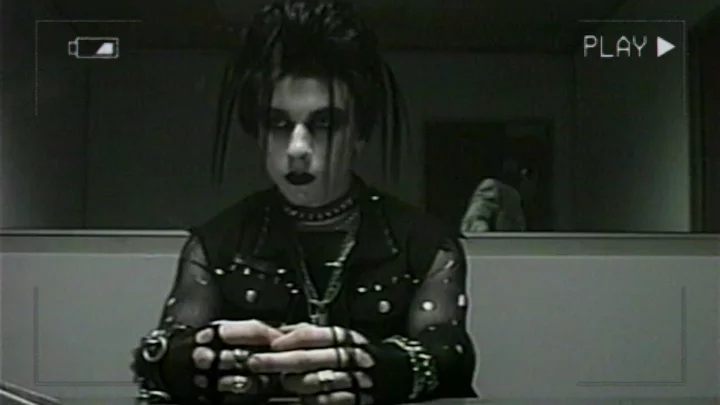Scott Derrickson is known for his terrifying mainstream horror films, from his feature-length directorial debut The Exorcism of Emily Rose to more recent fare like The Black Phone. While grisly visuals are nothing new to the guy behind Sinister and its ilk, Derrickson raises the bar with his segment in V/H/S/85 by incorporating an obscure art-noise track that will chill your blood — especially once you really listen to it.
Let's get into the murdery stuff in "Dreamkill."
Derrickson's V/H/S/85 contribution, "Dreamkill," begins with a police detective who receives what's sure to be a fake snuff film in the mail — only to visit a blood-spattered crime scene a few nights later that looks awfully familiar.
Derrickson uses various sources of footage to put together his narrative, and to keep the viewer on their toes. We see the officers in the station from the vantage point of the always-rolling security cameras, for example. And the VHS tapes that feature the murders are composed of random footage of parties or snippets of recorded TV shows, for reasons that are explained as the segment unfurls.
But when Derrickson switches from goofy teen stuff to the footage of the killer in his car, on his way to his second victim's house, the tone changes. And if you listen carefully, you can hear the opening beats from proto-industrial noise band Throbbing Gristle's terrifying song, "Hamburger Lady."
You'd be forgiven for not realizing the uneasy noise, the drone and hum, is actually a song at all, and although eventually you do hear some singing occur, it's more like chanting. It's the sound of the late Genesis Breyer P-Orridge murmuring about a burn victim nicknamed the "Hamburger Lady" by the orderlies tasked with her care. It's hard to tell how different the version (or perhaps the sound levels) are between this remastered version and what's used in "Dreamkill," or if the lyrics are obscured on purpose, but the occasional phrase that breaks through the noise (such as "She's dying / she is burned from the waist up") just makes the nightmarish scenario unfolding before you even more awful.
In an interview with Bloody Disgusting, Derrickson described it as "the most disturbing song ever recorded." And I would agree, if only because I haven't really sat down and listened to Throbbing Gristle's entire oeuvre, like "Zyklon B Zombie" or "Maggot Death" or the infamous "Slug Bait," which, as Pitchfork notes, was described in a press release about a recent TG rerelease as "a song about eating a baby."
Who was Throbbing Gristle?
Cosey Fanni Tutti and Breyer in their Hackney garden, in London, England, 1978. Credit: Photo by Ruby Ray / Getty ImagesThrobbing Gristle was sort of a band that sprung out of a shambolic art movement in the UK called COUM Transmissions, which lasted from around 1969 to 1976. Transgression was the name of the game for their live performances. Art critic Mark Hudson described one such "happening" as "a piece of street theatre involving a pram-full of raw chicken and used sanitary towels." At one point, Tory MP Nicholas Fairbairn declared them "wreckers of Western civilization."
The two people most famously associated with COUM, Cosey Fanni Tutti and P-Orridge, went on to form Throbbing Gristle with Chris Carter and Peter "Sleazy" Christopherson. The result was a mash-up of frequently painful noise and distorted sounds, images, and descriptions of everything from sex work and bodily fluids to truly horrific violence.
If you're a serious gearhead, you can read all about the sound processor TG used called the Gristleizer here, as well as the other ways they created such discomfiting soundscapes. All I know is that when I saw them live in 2009 at the Brooklyn Masonic Temple (during a tentative and short-lived reunion),the cacophonic dirge made me simultaneously anxious, horny, and nauseous.
What's the deal with "Hamburger Lady"?
According to Carter, the lyrics from "Hamburger Lady" came from a letter sent to them by writer and mail artist "Blaster" Al Ackerman. The eponymous lady was thought to be patient of his. Fanni Tutti explained, "He sent this letter because it really had a huge effect on him… This long description of this woman that was in such a terrible state with burns. It impacted on us quite a lot, and that’s when Gen put down his letter to the track itself. And the sounds with it were to give a kind of feeling of being in a semi-conscious state like she would be, on the verge of the pain relief going away, which is what he was saying to us about it."
As the song annotation on Genius points out, it's not clear if the letter is based on real events or not. but Ackerman did reportedly work on burn wards at some point after returning from the Vietnam War. If you're really desperate to know what the letter contained, you can read some of it over at Genius, as transcribed from the sleeve of DOA: The Third and Final Report of Throbbing Gristle. There aren't really enough trigger warnings in the world, so proceed with caution.
After they split up in 1981, the main members of Throbbing Gristle went on to extraordinarily interesting careers in art, music, performance, and film that are definitely worth checking out, although they're not without significant controversy. You can read more in Wreckers of Civilisation: The Story of Coum Transmissions & Throbbing Gristle by Simon Ford, Fanni Tutti's memoir Art Sex Music, and/or P-Orridge's memoir Nonbinary. David Keenan's England's Hidden Reverse also touches on some of these players and their side projects.
And if "Hamburger Lady" merely piqued your interest, it's the perfect time of year to listen to The Unreleased Themes for Hellraiser by Christopherson's band Coil. We won't judge you.
How to watch: V/H/S/85 is now streaming on Shudder.









